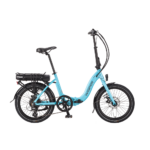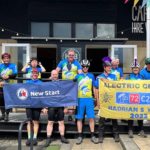It was on a 12 mile run that I inaugurated my Shimano A530 pedals, which are flat one side with the SPD mechanism on the other. It was my first time with clipless pedals, although my old Holdsworth has toe clips equipped with leather straps. Being used to leaning over quickly to release one when necessary, I was confident of mastering the new binding.
As recommended by the instructions, I first tested it with the bike immobile. Even with the SPD’s spring tension adjusted to its softest level, I noted that the sideways movement of the heel required to release the shoe has to be forceful and sharp.
Launching onto the cycle path I discovered that just placing the shoes on the pedals didn’t ensure the automatic engagement of the cleats into the mechanism. I had to find exactly the right position for them to connect. This may have been due to my choice of shoe: casual dual-purpose DZRs with relatively thick soles. However it only took a few miles to acquire the right reflex to click them in, usually on the first attempt.
With the required sharp movement, the heels are easily released. However, I noted a slight problem. On my Holdsworth, once the strap loosened, the foot of course stays on the pedal ready to hit the ground. With the SPDs, let’s assume you’ve unclipped the shoes anticipating an obstacle, as soon as you place them back on the pedals they immediately reengage! My current solutions are: a) if there are many obstacles ahead, keep to the pedals’ flat side; b) otherwise disengage at the last possible microsecond. Which can be interesting.
Continuing another few miles, I sensed I was absorbing the right reflexes. My shoes were disengaging and reengaging as required. In fact, why release them both? Only one needs to be freed when you know what you’re doing. So satisfied was I with my progress, that suddenly, for a reason that now escapes me, I decided to stop. I unclipped one foot to land gently on the other. It was during the passage from the vertical to the horizontal plane that the thought struck me that it would have been better to have released both.
I completed my journey slightly bruised but without further mishap.
Conclusion: although pulling up on the pedals called on muscles rarely used, they didn’t feel tired. The increased efficiency due to clipless pedals was pretty evident: I went faster with less effort. In particular, I didn’t notice the disappearance of the motor’s push past 25 km/h, at least on the flats. On the other hand, the use of SPD pedals requires a learning curve during which you must stay concentrated. Beware overconfidence!
As recommended by the instructions, I first tested it with the bike immobile. Even with the SPD’s spring tension adjusted to its softest level, I noted that the sideways movement of the heel required to release the shoe has to be forceful and sharp.
Launching onto the cycle path I discovered that just placing the shoes on the pedals didn’t ensure the automatic engagement of the cleats into the mechanism. I had to find exactly the right position for them to connect. This may have been due to my choice of shoe: casual dual-purpose DZRs with relatively thick soles. However it only took a few miles to acquire the right reflex to click them in, usually on the first attempt.
With the required sharp movement, the heels are easily released. However, I noted a slight problem. On my Holdsworth, once the strap loosened, the foot of course stays on the pedal ready to hit the ground. With the SPDs, let’s assume you’ve unclipped the shoes anticipating an obstacle, as soon as you place them back on the pedals they immediately reengage! My current solutions are: a) if there are many obstacles ahead, keep to the pedals’ flat side; b) otherwise disengage at the last possible microsecond. Which can be interesting.
Continuing another few miles, I sensed I was absorbing the right reflexes. My shoes were disengaging and reengaging as required. In fact, why release them both? Only one needs to be freed when you know what you’re doing. So satisfied was I with my progress, that suddenly, for a reason that now escapes me, I decided to stop. I unclipped one foot to land gently on the other. It was during the passage from the vertical to the horizontal plane that the thought struck me that it would have been better to have released both.
I completed my journey slightly bruised but without further mishap.
Conclusion: although pulling up on the pedals called on muscles rarely used, they didn’t feel tired. The increased efficiency due to clipless pedals was pretty evident: I went faster with less effort. In particular, I didn’t notice the disappearance of the motor’s push past 25 km/h, at least on the flats. On the other hand, the use of SPD pedals requires a learning curve during which you must stay concentrated. Beware overconfidence!






